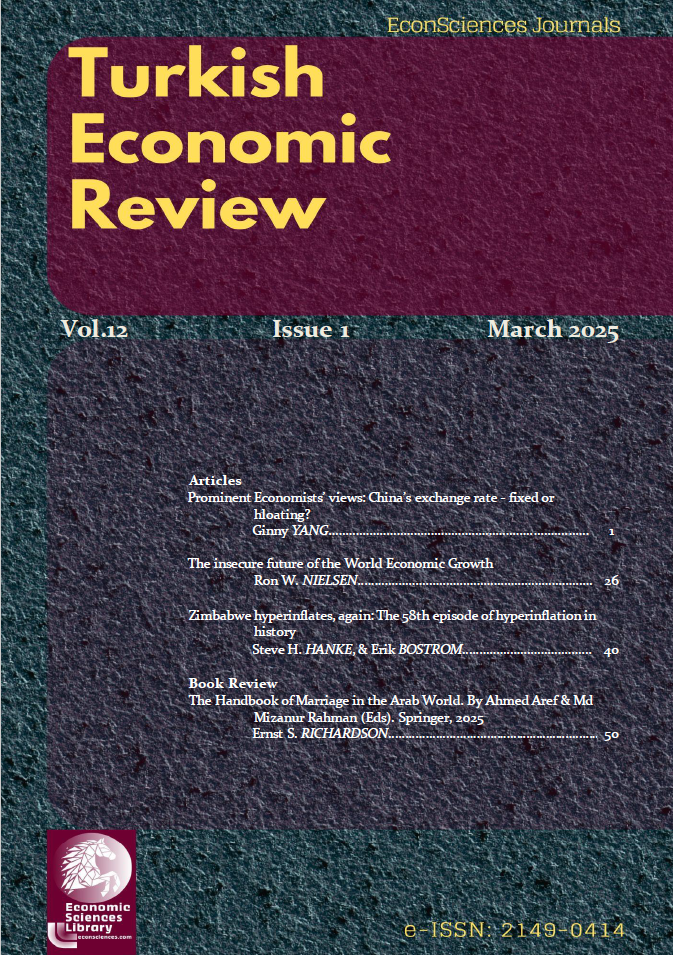Abstract
Growth rate of the world Growth Domestic Product (GDP) is analysed to determine possible pathways of the future economic growth. The analysis is based on using the latest data of the World Bank and it reveals that the growth rate between 1960 and 2014 was following a trajectory approaching asymptotically a constant value. The most likely prediction is that the world economic growth will continue to increase exponentially and that it will become unsustainable possibly even during the current century. A more optimistic but less realistic prediction is based on the assumption that the growth rate will start to decrease linearly. In this case, the world economic growth is predicted to reach a maximum, if the growth rate is going to decrease linearly with time, or to follow a logistic trajectory, if the growth rate is going to decrease linearly with the size of the world GDP.
Keywords. Economic growth; World economic growth; Gross Domestic Product; Predicting future growth; Exponential growth.
JEL. C01; C20; C50; C53; C60; C65; C80.
References
Bleaney, M. (1998). Purchasing power parity in the 1920s: Evidence for the Swiss Franc. Applied Economics Letters, 5(4), 239–241. https://doi.org/10.1080/135048598354394
Cagan, P. (1956). The monetary dynamics of hyperinflation. In M. Friedman (Ed.), Studies in the quantity theory of money (pp. 25–117). University of Chicago Press.
Frenkel, J. (1976). A monetary approach to the exchange rate: Doctrinal aspects and empirical evidence. The Scandinavian Journal of Economics, 78(2), 200–224. https://doi.org/10.2307/3439453
Hanke, S. H. (1999, April 28). Yugoslavia destroyed its own economy. Wall Street Journal. Retrieved from https://www.wsj.com/articles/SB925239570247458388
Hanke, S. H. (2008). Zimbabwe: Hyperinflation to growth. New Zanj Publishing House.
Hanke, S. H. (2016). Remembrances of a currency reformer: Some notes and sketches from the field (Studies in Applied Economics No. 55). Johns Hopkins Institute for Applied Economics, Global Health, and the Study of Business Enterprise.
Hanke, S. H. (2017, July 31). Zimbabwe, from disaster to disaster. Forbes. Retrieved from http://www.forbes.com/sites/stevehanke/2017/07/31/zimbabwe-from-disaster-to-disaster/-4878dc0f221a
Hanke, S. H. (2017, September 30). Zimbabwe inflates… Again. Forbes. Retrieved from https://www.forbes.com/sites/stevehanke/2017/09/30/zimbabwe-inflates-again/-72ad6b8a10d6
Hanke, S. H., & Bushnell, C. (2017). On measuring hyperinflation: Venezuela’s episode. World Economics, 18(3).
Hanke, S. H., & Krus, N. (2013). World hyperinflations. In R. Whaples & R. Parker (Eds.), Routledge handbook of major events in economic history (pp. 377–388). Routledge.
Hanke, S. H., & Kwok, A. (2009). On the measurement of Zimbabwe's hyperinflation. Cato Journal, 29(2), 353–364.
International Monetary Fund (IMF). (2017). World economic outlook October 2017: Seeking sustainable growth: Short-term recovery, long-term challenges. Retrieved from https://www.imf.org/en/Publications/WEO/Issues/2017/09/19/world-economic-outlook-october-2017
Mahdavi, S., & Zhou, S. (1994). Purchasing power parity in high-inflation countries: Further evidence. Journal of Macroeconomics, 16(3), 403–422. https://doi.org/10.1016/0164-0704(94)90013-1
McNown, R., & Wallace, M. (1989). National price levels, purchasing power parity, and cointegration: A test of four high inflation economies. Journal of International Money and Finance, 8(4), 533–545. https://doi.org/10.1016/0261-5606(89)90006-0
NYSEData.com. (n.d.). Consolidated volume in NYSE listed issues (Factbook). Retrieved from http://www.nyxdata.com/nysedata/asp/factbook/viewer_edition.asp?mode=table&key=3325&category=3
NYSE most active stocks - Markets Data Center - WSJ.com. (2017, October 14). Wall Street Journal. Retrieved from http://www.wsj.com/mdc/public/page/2_3021-activnyse-actives-20170929.html?mod=mdc_pastcalendar
Parker, R. E., & Whaples, R. (Eds.). (2013). Routledge handbook of major events in economic history. Routledge.
Phylaktis, K. (1992). Purchasing power parity and cointegration: The Greek evidence from 1920s. Journal of International Money and Finance, 11(5), 502–513. https://doi.org/10.1016/0261-5606(92)90035-7
September inflation rises 0.78 percent. (2017, October 17). The Herald. Retrieved October 18, 2017, from http://www.herald.co.zw/september-inflation-rises-078-percent/
Zhou, S. (1997). Purchasing power parity in high-inflation countries: A cointegration analysis of integrated variables with trend breaks. Southern Economic Journal, 64(2), 450–467. https://doi.org/10.2307/1060932
Zimbabwe Stock Exchange. (n.d.). Daily price sheet. Retrieved from http://www.zse.co.zw/daily-price-sheet/

This work is licensed under a Creative Commons Attribution-NonCommercial 4.0 International License.
